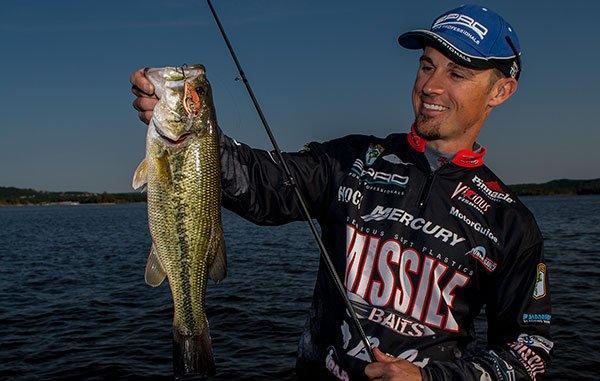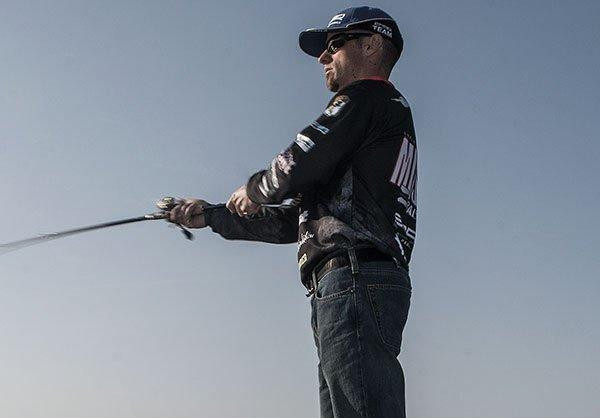You’ve been trying your best to get excited for Saturday’s local jackpot tournament. Under most circumstances, you would rush home from work only to spend countless hours in the garage prepping tackle for the impending slugfest on your home waters. This time is much different, however. It’s going to be cold this weekend. Not “cold” as in wearing a hoodie throughout the morning only to shed multiple layers as the sun warms the atmosphere. We’re talking a constant runny nose, numb fingertips and constant chills down your spine kind of cold.
Visions of shaky heads and other light line finesse techniques inundate your mind and haunt your dreams because, after all, cold water means slow fishing, right? Not exactly, according to Vicious Fishing pro John Crews. In some of the toughest cold water fishing conditions imaginable, Crews has had many of his best days going against the grain—staying shallow with a crankbait in-hand while other anglers flock to deeper water. With the right conditions, areas and proper crankbait selection this winter, you, too can create the “perfect storm” for some tremendous shallow water cranking action.
Conditions to look for
It’s no secret that crankbait fishing is a very condition-specific technique. Under normal circumstances, cranking is widely considered to be most effective in cloudy, low-light conditions. As the absence of prominent sunlight allows the fish to venture further from cover, they become more prone to chase a crankbait. In cold water cranking, however, Crews actually looks to the sun for assistance.
“In cold water, bass will inhabit the warmest water possible,” Crews said. “The warmer water helps them regulate their body temperatures, which makes the presence of sun a big factor when I’m trying to pick ‘em off with a crankbait.”
As the sun warms the water throughout the winter, bass tend to move upwards in the water column in order to get the maximum amount of warmth. Much like an alligator suns itself on the banks of a river, bass frequently revisit the shallows to take advantage of the warmer water. As these fish move into shallower water, they also feed more aggressively, making it a prime scenario for throwing a crankbait.
Shallow cold water cranking can be equally effective in both stained and clear water conditions, but in clear water situations, however, bass are more likely to spot any irregularities or unnatural characteristics in your bait and/or presentation. As cold water bass are generally more wary than warm water bass, stained water gives anglers more room for error. As a result, Crews makes it a point to find water with a light-to-moderate stain.
“Even if the bass move shallow in cold water, they’re still not going to be as active as they would be in other times of the year,” Crews said. “For this reason, I feel like stained water aids my attempt to fool suspicious bass.”
Key areas
You can throw a shallow crankbait all day long in cold water, but it simply won’t work well without identifying key areas that hold bass. While it’s absolutely true that cold water bass would prefer to be in deeper water, being in the right place when a small temperature rise occurs can make all the difference in the world.
“It’s pretty hard to go wrong when you’re targeting channel-swing banks,” Crews said. “They are perfect transition areas for bass, as the fish can stay deep while being able to quickly move to shallow cover to take advantage of small increases in temperature.”
Channel-swing banks are areas where the deeper water of the river or creek channel comes very close to the shallow water surrounding the bank. This gives cold water bass the best of both worlds: When it’s cloudy and nasty outside, they can hang out in the deeper water to retain heat. Conversely, when the sun is high, they are able to easily move shallow in order to soak up the heat of the sunlight.
In addition to these channel-swing banks, Crews also utilizes rocks when searching for a cold water shallow cranking bite. Rocks hold heat for much longer than other cover, so whenever he finds a rocky bank that has been baking in the sun, Crews knows what to do.
“I like to parallel rocky banks in cold water,” Crews said. “Bass will get as close as possible to the rocks in order to regulate their body temperatures in cold water, so I want to make long casts and slam a squarebill into every piece of rock that I can.”
Proper presentation and crankbait selection
In order to maximize your success while crankbait fishing in cold, shallow water, using the right presentation with specific crankbaits is of the utmost importance. Remember, these bass require a bit more coaxing than normal, but don’t let that scare you away. When fooling obstinate, cold water bass with a squarebill, Crews downsizes his line.
“Small line size is essential,” Crews said. “It allows the bait to go a little deeper while giving it more action. In the colder water, everything is going to be a little muted and not moving quite as fast, but having that light line gives the bait a wilder action, especially when it hits a piece of cover which can definitely trigger some huge bites.”
While line size is, in fact, paramount to success, it isn’t everything. To cater to the sluggish mood of the bass, Crews steals a few pages from the jerkbait’s playbook when chunking a squarebill in cold water. He begins each retrieve at a quick pace, but as soon as the crankbait hits a piece of cover, Crews hits the brakes with a short pause. Following the pause, a small twitch of the rod tip is often all that’s necessary to fool a big bass.
“I’m still going for a reaction bite, but I don’t want to overwhelm the fish with a crankbait screaming by its head,” Crews said. “Fishing the crankbait quickly is great, but only until you hit a piece of cover—that’s when you have to slow things down.”
In order for this presentation to be effective, Crews is extremely careful while choosing his crankbaits. As with many other techniques, shallow, cold water cranking success is very dependent upon keeping your bait in the strike zone for as long as possible. To achieve this, Crews opts for his signature line of Spro crankbaits.
“The Spro Little John is my number one go-to crankbait whenever I’m targeting shallow fish in cold water,” Crews said. “It has an extremely slow floating action, which allows me to pause it while keeping it in the strike zone. If they won’t eat the Little John, the Spro Fat John is my follow-up. With a bulkier profile, it still has the same slow-rising action that drives bass crazy.”
If you’re dreading the deep water finesse tactics this winter, don’t be afraid to go shallow with a crankbait. While other anglers fight over deep water spots, you’ll have the water all to yourself while also having the chance to land some of your biggest bass of the year. While it won’t necessarily result in big numbers of bass, it’s a perfect time to catch some giants off-guard.













